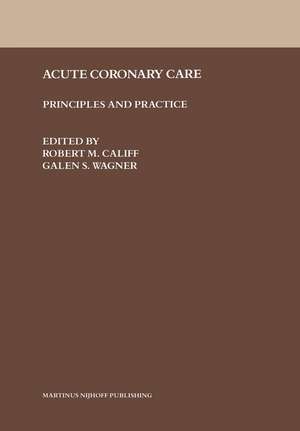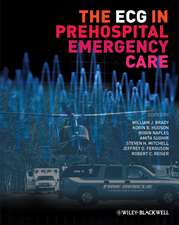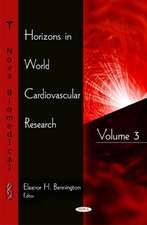Acute Coronary Care: Principles and Practice
Editat de Robert M. Califf, G.S. Wagneren Limba Engleză Paperback – 3 noi 2011
Preț: 391.93 lei
Preț vechi: 412.57 lei
-5% Nou
Puncte Express: 588
Preț estimativ în valută:
74.99€ • 78.30$ • 62.07£
74.99€ • 78.30$ • 62.07£
Carte tipărită la comandă
Livrare economică 04-18 aprilie
Preluare comenzi: 021 569.72.76
Specificații
ISBN-13: 9781461338307
ISBN-10: 1461338301
Pagini: 580
Ilustrații: 576 p.
Dimensiuni: 178 x 254 x 30 mm
Greutate: 0.99 kg
Ediția:1985
Editura: Springer Us
Colecția Springer
Locul publicării:New York, NY, United States
ISBN-10: 1461338301
Pagini: 580
Ilustrații: 576 p.
Dimensiuni: 178 x 254 x 30 mm
Greutate: 0.99 kg
Ediția:1985
Editura: Springer Us
Colecția Springer
Locul publicării:New York, NY, United States
Public țintă
ResearchCuprins
I. Pathophysiology of Ischemic Heart Disease.- 1. Factors that Regulate Transmural Myocardial Blood Flow Distribution.- 2. The Relationship between Coronary Blood Flow and Reversible and Irreversible Ischemic Injury.- 3. Energy Metabolism and Transport in the ischemic and Postischemic Myocardium.- 4. The Pathophysiology of Atherosclerosis of the Coronary Arteries and Changes that Predispose to Ischemic Heart Disease.- 5. The Role of Coronary Artery Spasm in Acute Ischemic Syndromes.- 6. The Role of Thrombosis in Acute Myocardial Ischemic Syndromes.- 7. The Biochemistry of Thrombolytic Agents.- 8. Clinical Pharmacology of Streptokinase.- 9. Terminology for Location of Acute Myocardial Infarcts.- 10. Subendocardial versus Transmural Infarction: Anatomic and Electrocardiographic Considerations.- 11. Hemodynamic Abnormalities in Acute Myocardial Infarction.- 12. Autonomic Imbalance during Acute Myocardial Ischemia and Infarction.- II. The Prediction and Prevention of Acute Myocardial Ischemia and Infarction.- 13. The Changing Prognosis of Patients with Unstable Angina and Acute Myocardial Infarction.- 14. Risk Factors that Predict Fatal and Nonfatal Cardiac Events.- 15. The Role of Nutrition in Atherogenesis and Acute Myocardial Infarction.- 16. The Role of Antithrombotic Therapy in the Acute Ischemic Syndromes.- 17. Clinical Trials of Modification of Mortality during Acute Myocardial Infarction.- III. Methods for Diagnosing and Sizing Myocardial Infarctions.- 18. Serum CK-MB in Diagnosis and Assessment of Acute Myocardial Infarction.- 19. The Ability of the QRS Complex to Determine the Location and Size of Myocardial Infarcts.- 20. Radionuclide Techniques for Diagnosing and Sizing of Myocardial Infarction.- 21. The Clinical Diagnosis of Right Ventricular Infarction.- IV. Methods for Monitoring the Patient with Acute Myocardial Ischemia.- 22. Hemodynamic Monitoring in Acute Myocardial Infarction.- 23. The Use of Echocardiographic Techniques for Determining Cardiac Function during Acute Myocardial Infarction.- 24. The Potential Usefulness of Doppler Ultrasound in Myocardial Infarction.- 25. The Use of Serial Radionuclide Angiography for Monitoring Function during Acute Myocardial Infarction.- 26. Tachyarrhythmias during Acute Myocardial Infarction and Options for Their Electrical Management.- V. Coronary Care: The Prehospital Phase.- 27. The Tiered Response Mobile Intensive Care System in the Management of Out-of-hospital Cardiac Arrest.- 28. The First Hour of Acute Myocardial Infarction Observed during Mobile Intensive Care.- 29. Cost Effectiveness of Mobile Intensive Care Unit for an Entire Community.- VI. Coronary Care : The Postadmission Phase.- 30. Optimal Identification of the Patient with Acute Myocardial Ischemia in the Emergency Room.- 31. Achieving Pain Relief with Physiologic Management and Analgesic Agents during Acute Myocardial Infarction.- 32. The Use of Intravenous Antiventricular Arrhythmic Agents during Acute Myocardial Infarction.- 33. The Clinical Use of Thrombolytic Agents.- 34. Methods for Detecting Salvage of Jeopardized Myocardium following Intracoronary Thrombolysis in Acute Myocardial Infarction.- 35. The Role of Surgery in Unstable Angina Pectoris and Acute Myocardial Infarction.- VII. Coronary Care: The Coronary Care Unit.- 36. The Evolution of Care of Patients with Unstable Angina and Myocardial Infarction.- 37. Organization and Administration of the Cardiac Care Unit.- 38. The Cost-effectiveness of Coronary Care Units.- VIII. Coronary Care: The Coronary Care Unit Phase.- 39. The Optimal Use of Temporary Pacingduring Acute Myocardial Infarction.- 40. Drug Interactions in Coronary Care.- 41. The Use of ?-adrenergic and Calcium-blocking Drugs during Acute Myocardial Ischemia and Infarction.- 42. Respiratory Care for Patients with Acute Myocardial Ischemia.- 43. Optimal Regulation of Preload and Afterload during Acute Myocardial Infarction.- 44. The Medical Management of Cardiogenic Shock due to Myocardial Necrosis.- 45. Surgical Treatment of Cardiogenic Shock following Acute Myocardial Infarction.- 46. Myocardial Infarct Expansion and Extension.- 47. Pericarditis following Myocardial Infarction.- 48. Preparation of the Patient, Family, and Staff for Imminent Death on a Coronary Care Unit.- IX. Coronary Care: The Predischarge Phase.- 49. Determination of the Optimal Time for Patient Mobilization and Hospital Discharge following Acute Myocardial Infarction.- 50. Identification and Prophylactic Treatment of Patients at High Risk of Late Postinfarction Sudden Death.- 51. The Quantification of Residual Ischemia in Patients Recovering from Acute Myocardial Infarction by Exercise Thallium-201 Scintigraphy.- 52. The Value of Radionuclide Angiography for Risk Assessment of Patients following Acute Myocardial Infarction.- 53. Optimal Use of Ambulatory Monitoring prior to Hospital Discharge following Acute Myocardial Infarction.- 54. Electrophysiologic Testing to Identify High-risk Patients after Acute Myocardial Infarction.- 55. Strategies for Assessing the Risk Status of Patients following Acute Myocardial Infarction or Unstable Angina.- X. Coronary Care: The Convalescent Phase.- 56. The Role of Outpatient Transtelephonic ECG Monitoring and Self-medication following Acute Myocardial Infarction.- 57. Minimizing Psychological Stress for Patients and Family following Acute MyocardialInfarction.- 58. Minimizing Disability and Optimizing Return to Work following Acute Myocardial Infarction.









